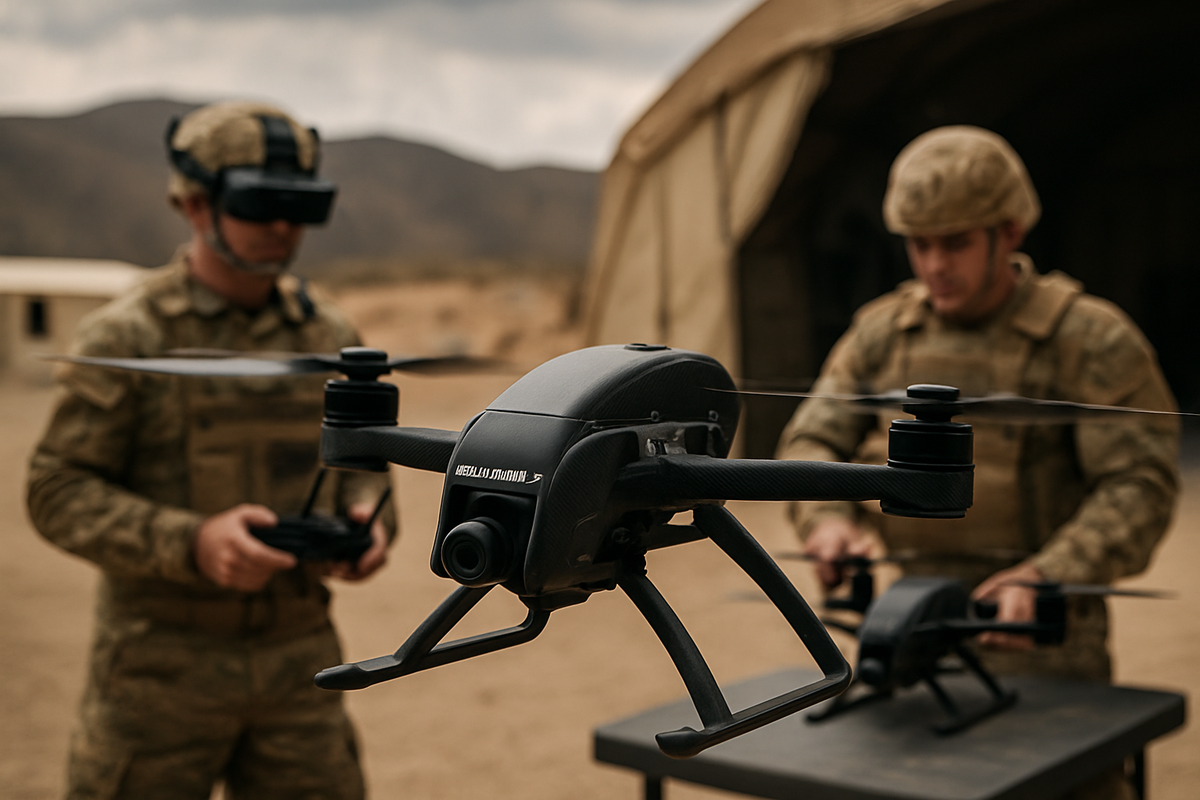
Draganfly (NASDAQ: DPRO), a leading drone solutions provider, has announced a pivotal contract win with the U.S. Army to supply its advanced Flex FPV (First Person View) drone systems. This landmark agreement extends beyond mere hardware delivery, encompassing comprehensive on-site manufacturing capabilities at overseas military facilities and extensive training for Army personnel. This strategic partnership signals a significant evolution in military procurement and operational readiness, poised to enhance the agility and self-sufficiency of U.S. forces in an increasingly complex global landscape. The contract, announced in late September 2025, positions Draganfly at the forefront of defense innovation, leveraging its commercial drone expertise for critical military applications.
The immediate implications of this contract are far-reaching. For Draganfly, it represents a substantial validation of its technology and a potentially significant revenue driver, with analysts expecting contributions as early as Q4 2025. For the U.S. Army, it marks a strategic embrace of decentralized drone operations, directly integrating lessons from contemporary conflicts to build a more resilient and adaptable fighting force. By bringing manufacturing and maintenance closer to the point of need, the Army aims to drastically reduce logistical delays and fortify its supply chains, fostering rapid innovation and operational independence for forward-deployed units.
Draganfly's Strategic Leap: Empowering the U.S. Army with On-Site Drone Capabilities
The contract, publicly announced on September 30, 2025, is a multi-faceted agreement designed to fundamentally transform how the U.S. Army deploys and sustains its tactical drone operations. At its core, Draganfly will supply its high-performance Flex FPV drone systems, renowned for their battlefield agility and precision. These drones boast impressive capabilities, including speeds exceeding 149 kilometers per hour (92 mph) and a payload capacity of up to 10 pounds (4.5 kg), making them versatile for missions ranging from reconnaissance to tactical payload delivery. A standout feature is their modular architecture, allowing operators to swiftly change arm and propeller sizes without specialized tools, thereby adapting to diverse mission requirements on the fly. Equipped with an onboard Sony camera, ultra-low latency video feed for FPV goggles and external monitors, and supporting both manual FPV and assisted autonomous flight modes, these systems are built for dynamic tactical environments. Crucially, the entire system and its supply chain are National Defense Authorization Act (NDAA)-compliant, addressing critical national security concerns.
A truly innovative aspect of this contract is the establishment of embedded, on-site manufacturing capabilities at overseas U.S. Forces facilities. This groundbreaking approach aims to drastically reduce logistical delays, ensure a secure and NDAA-compliant supply chain, and empower U.S. forces with the ability to maintain, adapt, and even design drones directly in the field. This move signifies a departure from traditional, centralized procurement models, fostering unprecedented operational agility and self-sufficiency for forward-deployed units. Complementing this, Draganfly will provide comprehensive training to Army personnel, covering both drone flight operation and the intricacies of on-the-ground manufacturing and maintenance. This dual-pronged training initiative is critical for enabling units to independently sustain their drone deployments and rapidly respond to evolving battlefield needs.
The journey leading to this significant contract has been shaped by the rapid evolution of drone technology in modern warfare. Draganfly's Flex FPV system itself was developed and refined through its direct support of frontline operations in Ukraine, providing invaluable real-world testing. Prior to this contract, Draganfly had already delivered Flex FPV systems to a major U.S. military prime contractor in June 2025, supporting allied forces. The U.S. Army's increasing embrace of FPV drone capabilities was further highlighted during exercises like Swift Response 2025 in Lithuania, where paratroopers successfully utilized in-house-built FPV drones for strike operations. A pivotal moment came in August 2025 with the U.S. Army's first recorded air-to-air kill using an armed FPV drone, unequivocally demonstrating the expanding combat roles of these platforms. Draganfly officially launched its FlexForce Modular FPV UAV System, a precursor to the Flex FPV, in May 2024, specifically targeting government and military buyers.
Key players instrumental in this deal include Cameron Chell, President and CEO of Draganfly, who has championed the strategic importance of this partnership. While specific U.S. Army personnel are not publicly named, the contract reflects the Army's broader strategic shift towards decentralized and agile drone operations. Furthermore, Draganfly's existing strategic partnership with Global Ordnance, a U.S. Defense Logistics Agency (DLA) prime contractor, has likely played a crucial role in accelerating the adoption of Draganfly's UAS platforms within U.S. defense circles. The initial market reaction to the announcement was overwhelmingly positive for Draganfly (NASDAQ: DPRO). The company's stock experienced significant surges, with reports of intraday jumps ranging from 13% to over 26%, reaching a 52-week high and seeing a substantial increase in trading volume. Analysts and investors have lauded the contract as a "transformative" and "strategic breakthrough," recognizing that the embedded manufacturing and training components suggest a long-term, sustainable partnership rather than a one-off sale, potentially creating a "sustainable competitive moat" for Draganfly. While specific financial details, such as the dollar value, were not disclosed, the strategic implications alone have fundamentally altered Draganfly's investment narrative, rendering previous valuations potentially outdated.
Market Ripples: Winners, Losers, and Strategic Shifts in the Defense Drone Sector
Draganfly's (NASDAQ: DPRO) landmark contract with the U.S. Army is poised to send significant ripples across the defense and aerospace industries, creating clear winners and intensifying competition for others. The multifaceted nature of the deal—encompassing drone supply, on-site manufacturing, and comprehensive training—positions Draganfly as a pivotal player in the evolving landscape of military technology.
Draganfly (NASDAQ: DPRO): The Undeniable Victor Without a doubt, Draganfly stands as the primary beneficiary of this contract. The agreement serves as a profound validation of the company's two-and-a-half decades of expertise in unmanned aerial vehicles (UAVs) and its strategic pivot towards North American production and National Defense Authorization Act (NDAA) compliance. This contract is not merely a hardware sale; its emphasis on embedded manufacturing and training signifies a long-term strategic partnership, providing Draganfly with a sustainable revenue stream and a formidable competitive moat. The market's reaction was immediate and enthusiastic, with Draganfly's stock soaring by over 66% following the announcement, reaching a 52-week high and signaling a significant shift in investor sentiment. While the company has historically faced challenges such as unprofitability and revenue fluctuations, this foundational contract, coupled with a strong balance sheet boasting over $22.5 million in cash and a recent $25 million offering, provides the capital and credibility needed to scale production and execute on this transformative opportunity.
Direct Competitors: Heightened Scrutiny and Strategic Adaptations For direct competitors in the military's small UAS and FPV drone space, Draganfly's win translates into intensified competition and a need for strategic re-evaluation. Companies like Skydio, a prominent U.S. drone manufacturer, which recently saw its position as an Army supplier challenged by Red Cat Holdings (NASDAQ: RCAT) in a separate contract, will face an even more crowded field. Draganfly's success in the FPV segment further solidifies the demand for domestically produced, NDAA-compliant tactical drones, potentially limiting future opportunities for other players. Similarly, Red Cat Holdings (NASDAQ: RCAT), through its subsidiaries Teal Drones and FlightWave Aerospace, has been actively supplying NDAA-compliant drones to the DoD and recently launched its FANG™ FPV drone line. While Red Cat has secured its own successes, including winning the Army's Short Range Reconnaissance program, Draganfly's contract directly competes in the rapidly growing FPV niche, necessitating continued innovation and differentiation from Red Cat.
Even larger players like AeroVironment (NASDAQ: AVAV), a significant supplier of small UAS such as the Raven and Puma, and producer of Switchblade loitering munitions, might view this as a missed opportunity to expand their tactical FPV offerings. While AeroVironment's portfolio is broader, the U.S. Army's clear commitment to FPV technology, as demonstrated by the Draganfly contract, underscores a market segment that all defense drone manufacturers will need to address. Smaller U.S. manufacturers like Advanced Aircraft Company, Ascent AeroSystems, and ModalAI, while benefiting from the overall push for domestic production, will find the competitive landscape more challenging as a significant portion of the FPV budget may now be allocated to Draganfly. These companies will likely respond by doubling down on research and development, emphasizing unique features, advanced AI integration, and specialized mission capabilities to carve out their own niches.
Broader Defense Contractors and Supply Chain Beneficiaries Larger defense contractors such as Lockheed Martin (NYSE: LMT), Northrop Grumman (NYSE: NOC), and Raytheon Technologies (NYSE: RTX), typically focused on more extensive and complex defense systems, are unlikely to be directly impacted in their core business. However, Draganfly's success could signal a growing trend towards modular, decentralized, and rapidly deployable tactical assets. These industry giants might explore partnerships with agile drone companies like Draganfly or become suppliers of specialized components (e.g., advanced sensors, secure communication systems) that integrate into these smaller platforms. Companies like L3Harris Technologies (NYSE: LHX), which supplies optics and communication systems, could see indirect benefits from increased demand for such components in the burgeoning tactical drone market.
Furthermore, companies involved in the NDAA-compliant drone component supply chain stand to gain significantly. Manufacturers of flight controllers, cameras, motors, batteries, and secure communication modules that meet stringent compliance standards will likely experience increased demand. The contract's emphasis on localized manufacturing at overseas U.S. Forces facilities could also stimulate regional demand for specific component assembly or sub-assembly work, provided these operations adhere to compliance requirements. Lastly, specialized military drone training providers are poised for growth. Beyond Draganfly's own training division, entities offering tactical drone training, including FPV drone tactics, such as Pendleton UAS Range, T1G, and Navmar Applied Sciences Corporation, could see increased demand as the U.S. Army expands its FPV capabilities and training requirements. Conversely, component manufacturers reliant on non-NDAA compliant supply chains or those focused solely on commercial markets may find themselves at a disadvantage in this rapidly militarizing segment.
A New Era of Decentralized Warfare: Wider Significance of the Draganfly Contract
Draganfly's contract with the U.S. Army for Flex FPV drones represents far more than a simple procurement deal; it signifies a profound shift in military technology adoption, strategic thinking, and the future of drone warfare. This event aligns with and accelerates several broader industry trends, with ripple effects extending across the defense sector and into the regulatory landscape.
The Ascendance of FPV Drones and Agile Military Technology The U.S. Army's embrace of Draganfly's Flex FPV systems underscores the critical role that First-Person View drones are now playing in modern conflict. Heavily influenced by their proven effectiveness in conflicts such as the war in Ukraine, FPV drones offer unparalleled tactical advantages: small size, extreme agility, high speeds (the Flex FPV can exceed 149 km/h or 92 mph), and a remarkably low cost compared to traditional military hardware. These attributes enable precision strikes, real-time reconnaissance, and target identification, even against rapidly moving targets, while allowing operators to be "present in the contact point without physically being there." The Army's active experimentation, including successful exercises with in-house-built FPV drones and the first recorded air-to-air kill by an armed FPV drone in August 2025, solidifies FPV as a disruptive technology. This contract marks a decisive move towards more agile, adaptable, and cost-effective combat strategies, shifting away from sole reliance on large, expensive, and often slow-to-deploy traditional drone systems.
This contract also heralds a significant paradigm shift in military technology adoption and sustainment. The inclusion of on-site manufacturing capabilities at overseas U.S. Forces facilities and comprehensive training for Army personnel is revolutionary. This embedded manufacturing model is designed to drastically reduce logistical delays, fortify secure and NDAA-compliant supply chains, and empower frontline units to adapt, maintain, and even customize drones for specific missions in real-time. This decentralization of production and maintenance enhances force readiness and operational agility, directly addressing the high consumption rates of FPV drones in active combat. This approach is a direct response to U.S. government directives aimed at bolstering domestic drone manufacturing and prioritizing American-made products, recognizing drones as a generational battlefield innovation crucial for national security.
Ripple Effects: Competition, Partnerships, and Policy The ripple effects of this contract will be felt throughout the defense drone ecosystem. For competitors, Draganfly's success will undoubtedly intensify competition in the FPV drone development space. Other defense contractors and commercial drone companies will be compelled to accelerate their investment in military FPV technology, potentially adopting similar embedded manufacturing and training models to remain competitive. The emphasis on NDAA compliance and U.S.-made components will further pressure companies with foreign supply chain dependencies, creating a distinct advantage for those with secure, domestic production capabilities. This will likely lead to a reorientation of R&D efforts towards modular designs, high-speed performance, increased payload versatility, and advanced autonomous capabilities, mirroring the Flex FPV system's features. Strategic partnerships and acquisitions of smaller FPV drone developers by larger defense prime contractors are also likely outcomes as companies scramble to establish or expand their presence in this burgeoning market.
For Draganfly's existing partners, such as Global Ordnance, this contract solidifies their strategic importance and could lead to further collaborations. Companies supplying NDAA-compliant components for FPV drones—from cameras and sensors to flight controllers and batteries—are also poised to experience increased demand. On the regulatory and policy front, this contract strongly reinforces the "Buy American" mandate, driven by national security and supply chain resilience concerns. It aligns with legislative efforts like the American Security Drone Act of 2023 and the LEAD Act, which aim to expand the Defense Innovation Unit's (DIU) Blue UAS List and streamline the procurement of compliant drones. Furthermore, recent Department of Defense policy changes allowing lower-level commanders to directly procure small UAS as "consumables" will accelerate acquisition and deployment, while the government continues to work on streamlining regulatory hurdles for drone innovation.
Historical Context: Echoes of Past Military Revolutions The strategic shift embodied by the Draganfly contract resonates with several historical military technology transformations. It can be compared to the transition from manned reconnaissance to early drones during the Vietnam War, where UAVs reduced pilot exposure to hostile territory, much like FPV drones allow soldiers to be "present in the contact point without physically being there." The introduction of precision-guided munitions (PGMs) also serves as a parallel; just as PGMs revolutionized warfare by enabling accurate strikes, FPV drones offer precision targeting for smaller objectives at a fraction of the cost. Perhaps most strikingly, the low cost and accessibility of FPV drones, coupled with the ability for localized innovation, can be likened to the widespread adoption of small arms or the ingenuity in creating Improvised Explosive Devices (IEDs). These technologies, while individually less powerful, can be mass-produced and deployed in large numbers, overwhelming adversaries through sheer quantity and rapid adaptation, a lesson vividly demonstrated in the Ukrainian conflict. This contract, therefore, is not merely an acquisition; it signifies a fundamental evolution in how the U.S. military approaches technology development, procurement, and battlefield strategy, prioritizing agility, decentralization, and domestic self-sufficiency in an era of rapidly transforming drone warfare.
The Road Ahead: Short-Term Gains and Long-Term Transformations
Draganfly's (NASDAQ: DPRO) landmark contract with the U.S. Army is set to catalyze immediate shifts and pave the way for long-term transformations, not just for the company but for the entire defense drone industry. The implications span from Draganfly's operational scaling to the strategic adaptations required of its competitors and the emergence of new market opportunities and challenges.
Short-Term Momentum and Execution for Draganfly In the immediate future, the U.S. Army contract provides Draganfly with substantial validation and a significant boost to its market standing. The surge in its stock price reflects a renewed investor confidence, positioning the company as a key player in the rapidly expanding defense sector. The short-term focus for Draganfly will be on the efficient execution of the initial orders, successfully scaling its production capabilities for the Flex FPV drones, and effectively establishing and integrating the on-site manufacturing and training programs at overseas military facilities. Demonstrating tangible revenue growth and a clear path to improved profitability from this contract will be crucial to sustain positive market sentiment and justify its current valuation, especially given its historical challenges with profitability and revenue fluctuations.
Long-Term Strategic Positioning and Innovation Looking further ahead, this contract strategically embeds Draganfly within the U.S. military's modernization efforts, particularly as the Army fully embraces FPV drone technology. The emphasis on embedded manufacturing and NDAA-compliant supply chains aligns Draganfly with critical defense priorities that favor domestic production and secure technology. This foundational partnership could serve as a springboard for securing additional contracts within the U.S. military and with allied nations, significantly expanding Draganfly's footprint in the burgeoning global military drone market. Continued investment in AI-driven innovations, such as enhanced autonomous flight, improved payload capacity, energy efficiency, and potentially swarm capabilities, will be vital for Draganfly to maintain its competitive edge and capitalize on the evolving demands of modern warfare. Its modular drone designs, already proven adaptable for various missions, provide a robust platform for future military applications.
Strategic Pivots Across the Defense Drone Industry The "paradigm shift" in defense drone technology, driven by the effectiveness of FPV drones, necessitates strategic pivots across the industry:
- For Draganfly: The company must prioritize scaling its manufacturing and ensuring robust, NDAA-compliant supply chains. Continuous investment in AI and machine learning will be key for enhancing autonomy, payload, and swarm capabilities. Expanding its training and support services will also be critical, given the contract's emphasis on comprehensive personnel instruction.
- For Competitors: Companies like Red Cat Holdings (NASDAQ: RCAT) and AeroVironment (NASDAQ: AVAV) must double down on NDAA compliance and domestic production, as these are becoming baseline requirements for significant defense contracts. The U.S. Army's interest in low-cost, "attritable" FPV drones (less than $2,000 per unit) and the Pentagon's Replicator program will compel competitors to design and produce affordable, high-impact, expendable drones. Integration of AI and swarm technology will be paramount, as will the development of robust counter-drone capabilities, creating a continuous "cat-and-mouse game" of technological advancement. Larger defense contractors may continue to form alliances with or acquire agile tech startups to access innovative solutions and diversify their industrial base.
Emerging Market Opportunities and Challenges The global military drone market is projected for explosive growth, with some estimates reaching USD 87.63 billion by 2030. This creates massive opportunities for FPV drone manufacturers, with demand potentially reaching millions globally due to their tactical effectiveness and cost-efficiency. The anti-drone market is also experiencing tremendous growth, projected to reach USD 7.05 billion by 2029, offering significant avenues for innovation in detection, identification, and neutralization technologies. Opportunities also abound in AI and autonomous systems, decentralized production models, and new applications like cargo delivery and logistics.
However, significant challenges persist. The rapid technological evolution means drones and counter-drone systems can become obsolete quickly, demanding continuous R&D and rapid adaptation. Supply chain vulnerabilities, especially regarding NDAA-compliant components, remain a concern. High development and procurement costs, complex regulatory and legal frameworks, and persistent cybersecurity risks pose ongoing hurdles. Limitations in drone endurance and range, while less critical for FPV drones, also remain a challenge for broader military applications.
Potential Scenarios for the Defense Drone Industry Looking ahead, several scenarios could unfold:
- Dominance of Attritable FPV Drones: Widespread adoption of low-cost, expendable FPV drones could fundamentally alter the economics of warfare, leading militaries to integrate them into standard tactical units in vast numbers.
- Proliferation of AI and Swarm Warfare: AI-driven autonomous drone swarms will become increasingly sophisticated, capable of coordinating complex attacks, demanding advanced AI-enabled command and control systems.
- Intensified Counter-Drone Arms Race: A continuous technological competition will drive rapid innovation in detection, jamming, kinetic, and directed energy solutions for counter-drone systems.
- Decentralized Production and Maintenance: The Draganfly model of on-site manufacturing and training will become more prevalent, reducing logistical bottlenecks and enabling rapid iteration and customization of drones in the field.
- Evolving Military Doctrine: The integration of drones will continue to redefine military doctrine, training protocols, and operational planning, with human soldiers working in increasingly close collaboration with drone systems.
Draganfly's contract positions it favorably in this dynamic environment. Its success hinges on efficient execution, continuous innovation, and strategic alignment with the military's growing emphasis on cost-effective, AI-enabled, and domestically produced FPV drone solutions.
Conclusion: A New Horizon for Draganfly and Defense Innovation
Draganfly (NASDAQ: DPRO) recently secured a pivotal contract with the U.S. Army for its Flex FPV (First Person View) drone systems, coupled with on-site manufacturing and comprehensive training. This represents a watershed moment for the company and a significant inflection point in military technology. This is not merely a transaction for hardware; it is a foundational partnership that redefines operational readiness and supply chain resilience for U.S. forces in an era of rapidly evolving threats.
Summary of Key Takeaways The core of this agreement, announced in late September 2025, centers on three critical components: the delivery of Draganfly's high-performance, modular Flex FPV drones, the establishment of embedded manufacturing capabilities at overseas U.S. Forces facilities, and extensive flight and manufacturing training for Army personnel. This innovative approach validates Draganfly's technology and business model, aligning it perfectly with the U.S. military's strategic pivot towards decentralized, agile, and self-sufficient drone operations. The immediate and substantial surge in Draganfly's stock price following the announcement underscores the market's recognition of this contract's transformative potential, signaling strong investor confidence in the company's future growth trajectory. The contract also strongly reinforces the "Buy American" mandate and the imperative for NDAA-compliant supply chains in defense procurement.
Assessing the Market Moving Forward The defense drone market is poised for explosive growth, with projections indicating a rapid expansion in the coming years. FPV drones, proven as a game-changer in modern conflicts, are set to become a staple in military arsenals globally, with the U.S. Army planning formal integration by fiscal year 2025 and deployment to infantry platoons by 2026. This burgeoning demand, coupled with a strong emphasis on domestic and NDAA-compliant solutions due to geopolitical tensions and supply chain vulnerabilities, creates a fertile ground for North American manufacturers like Draganfly. The market will continue to witness rapid technological evolution, particularly in AI, autonomous flight, swarm capabilities, and counter-drone systems, all of which will redefine modern warfare strategies and open continuous avenues for innovation.
Significance and Lasting Impact This contract fundamentally elevates Draganfly's standing in the defense sector. By not just supplying drones but also empowering military units with localized manufacturing and comprehensive training, Draganfly is contributing to a new model of operational agility and self-sufficiency. This decentralized approach could set a powerful precedent for future defense procurement, influencing other branches of the U.S. military and allied forces to adopt similar strategies. For Draganfly, it validates years of technology development and strategic alignment, establishing a significantly higher baseline for its future growth and potential valuation within the aerospace and defense industry. The lasting impact will be a more resilient, adaptable, and technologically advanced military ecosystem, capable of rapidly responding to dynamic global challenges.
Investor Outlook for Draganfly (NASDAQ: DPRO) For investors in Draganfly (NASDAQ: DPRO), several key factors warrant close attention in the coming months:
- Execution and Expansion of the U.S. Army Contract: The successful execution of the initial phases, including scaling production, delivery, and the establishment of overseas manufacturing and training programs, will be paramount. Positive progress here could lead to follow-on orders and program expansion, driving further revenue. Analysts anticipate revenue contributions as early as Q4 2025, with more significant impact expected in 2026.
- Revenue Growth and Path to Profitability: While the contract is a significant milestone, Draganfly has historically faced challenges with declining revenue and profitability. Investors should closely watch how quickly this contract translates into sustainable revenue growth and a clear path toward profitability.
- Further Defense and Public Safety Contracts: Look for additional contract wins with the U.S. military, other government agencies, or allied nations, particularly those prioritizing NDAA-compliant and domestically sourced drone solutions.
- Technological Advancements and Competitive Landscape: Draganfly operates in a competitive market. Investors should assess the company's ability to continue innovating, particularly in areas like AI integration, autonomous capabilities, and counter-drone measures, to maintain its competitive edge against well-funded rivals such as Skydio and Red Cat Holdings (NASDAQ: RCAT).
- Valuation Assessment: Following the contract announcement, Draganfly's stock experienced a significant rally. Some analyses suggest its price-to-sales ratio is currently high compared to industry peers, implying that exceptional growth is already priced into the stock. Investors should conduct thorough due diligence to determine if the current valuation is justified by future growth prospects or if there is a risk of correction if expectations are not met.
Broader Defense Drone Market Outlook The defense drone market is poised for continued robust growth, driven by increasing global defense budgets, geopolitical tensions, and the escalating demand for advanced intelligence, surveillance, reconnaissance (ISR), and combat capabilities. FPV drones are expected to become a staple in military arsenals worldwide. The shift towards decentralized manufacturing and NDAA compliance will continue to shape procurement strategies, favoring companies that can provide secure, domestically produced solutions. Furthermore, the integration of advanced technologies like AI, swarm capabilities, and anti-drone systems will redefine modern warfare strategies, creating continuous opportunities for innovation and growth within the sector.
This content is intended for informational purposes only and is not financial advice





